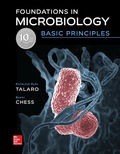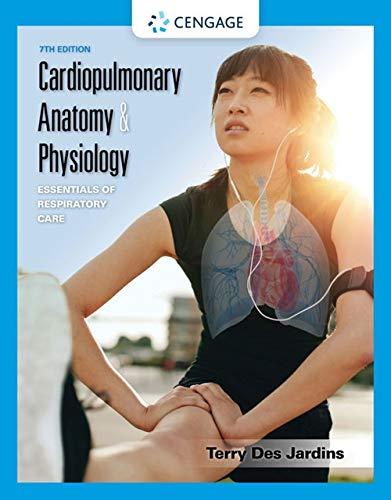
EBK FOUNDATIONS IN MICROBIOLOGY: BASIC
10th Edition
ISBN: 9781259916045
Author: TALARO
Publisher: MCGRAW HILL BOOK COMPANY
expand_more
expand_more
format_list_bulleted
Concept explainers
Question
Chapter 2.2, Problem 13CYP
Summary Introduction
To analyse:
The difference between an anion and a cation with the help of examples.
Introduction:
Atoms combine with other atoms by forming
Expert Solution & Answer
Want to see the full answer?
Check out a sample textbook solution
Students have asked these similar questions
Amino
Acid Coclow
TABle
3'
Gly
Phe
Leu
(G)
(F) (L)
3-
Val
(V)
Arg (R)
Ser (S)
Ala
(A)
Lys (K)
CAG
G
Glu
Asp (E)
(D)
Ser
(S)
CCCAGUCAGUCAGUCAG
0204
C
U
A G
C
Asn
(N)
G
4
A
AGU
C
GU
(5)
AC
C
UGA
A
G5
C
CUGACUGACUGACUGAC
Thr
(T)
Met (M)
lle
£€
(1)
U
4
G
Tyr
Σε
(Y)
U
Cys (C)
C
A
G
Trp (W) 3'
U
C
A
Leu
בוט
His
Pro
(P)
££
(H)
Gin
(Q)
Arg
흐름
(R)
(L)
Start
Stop
8. Transcription and Translation Practice: (Video 10-1 and 10-2)
A. Below is the sense strand of a DNA gene. Using the sense strand, create the antisense
DNA strand and label the 5' and 3' ends.
B. Use the antisense strand that you create in part A as a template to create the mRNA
transcript of the gene and label the 5' and 3' ends.
C. Translate the mRNA you produced in part B into the polypeptide sequence making sure
to follow all the rules of translation.
5'-AGCATGACTAATAGTTGTTGAGCTGTC-3' (sense strand)
4
What is the structure and function of Eukaryotic cells, including their organelles? How are Eukaryotic cells different than Prokaryotic cells, in terms of evolution which form of the cell might have came first? How do Eukaryotic cells become malignant (cancerous)?
What are the roles of DNA and proteins inside of the cell? What are the building blocks or molecular components of the DNA and proteins? How are proteins produced within the cell? What connection is there between DNA, proteins, and the cell cycle? What is the relationship between DNA, proteins, and Cancer?
Chapter 2 Solutions
EBK FOUNDATIONS IN MICROBIOLOGY: BASIC
Ch. 2.1 - Prob. 1ELOCh. 2.1 - Prob. 2ELOCh. 2.1 - Prob. 3ELOCh. 2.1 - Prob. 4ELOCh. 2.1 - Prob. 5ELOCh. 2.1 - Prob. 1CYPCh. 2.1 - Prob. 2CYPCh. 2.1 - Prob. 3CYPCh. 2.1 - Prob. 4CYPCh. 2.1 - Prob. 5CYP
Ch. 2.1 - Prob. 6CYPCh. 2.2 - Prob. 6ELOCh. 2.2 - Prob. 7ELOCh. 2.2 - Prob. 8ELOCh. 2.2 - Prob. 9ELOCh. 2.2 - Prob. 10ELOCh. 2.2 - Prob. 11ELOCh. 2.2 - 7. Explain how the concepti of molecules and...Ch. 2.2 - Prob. 8CYPCh. 2.2 - Prob. 9CYPCh. 2.2 - Prob. 10CYPCh. 2.2 - Prob. 11CYPCh. 2.2 - Prob. 12CYPCh. 2.2 - Prob. 13CYPCh. 2.2 - Prob. 14CYPCh. 2.3 - Prob. 12ELOCh. 2.3 - 13. Explain solutes, solvents, and hydration.Ch. 2.3 - Prob. 14ELOCh. 2.3 - 15. Describe the pH scale and how it was derived;...Ch. 2.3 - Prob. 15CYPCh. 2.3 - Prob. 16CYPCh. 2.3 - 17. What properties of water make it an effective...Ch. 2.3 - Prob. 18CYPCh. 2.3 - 19. What determines whether a substance is an acid...Ch. 2.4 - 16. Describe the chemistry of carbon and the...Ch. 2.4 - Prob. 17ELOCh. 2.4 - Prob. 18ELOCh. 2.4 - Prob. 20CYPCh. 2.4 - Prob. 21CYPCh. 2.4 - Prob. 22CYPCh. 2.4 - 23. What are functional groups?Ch. 2.4 - Prob. 24CYPCh. 2.5 - 19. Define carbohydrate and know the functional...Ch. 2.5 - Prob. 20ELOCh. 2.5 - 21. Discuss the functions of carbohydrates in...Ch. 2.5 - Prob. 25CYPCh. 2.5 - Prob. 26CYPCh. 2.5 - 27. What are some of the functions of...Ch. 2.6 - 22. Define lipid, triglyceride, phospholipid,...Ch. 2.6 - 23. Describe how an ester bond is formed.Ch. 2.6 - Prob. 24ELOCh. 2.6 - 28. Draw simple structural molecules of...Ch. 2.7 - 25. Describe the structures of peptides and...Ch. 2.7 - 26. Characterize the four levels of protein...Ch. 2.7 - 27. Summarize some of the essential functions of...Ch. 2.7 - Prob. 29CYPCh. 2.7 - 30. Differentiate between a peptide, a...Ch. 2.7 - 31. Explain what causes the various levels of...Ch. 2.7 - 32. What functions do proteins perform in a cell?Ch. 2.8 - 28. Identify a nucleic acid and differentiate...Ch. 2.8 - Prob. 29ELOCh. 2.8 - 30. Explain how the DNA code may be copied, and...Ch. 2.8 - 33. Describe a nucleotide and a polynucleotide,...Ch. 2.8 - 34. Name the two purines and the three...Ch. 2.8 - 35. What are the functions of RNA?Ch. 2.8 - 36.What is ATP, and how does it function in cells?Ch. 2.L1 - 1. The smallest unit of matter with unique...Ch. 2.L1 - 2. The charge of a proton is exactly balanced by...Ch. 2.L1 - Prob. 3MCQCh. 2.L1 - Prob. 4MCQCh. 2.L1 - Prob. 5MCQCh. 2.L1 - Prob. 6MCQCh. 2.L1 - Prob. 7MCQCh. 2.L1 - 8. An atom that can donate electrons during a...Ch. 2.L1 - 9. In a solution of NaCl and water, NaCl is the...Ch. 2.L1 - 10. A solution with a pH of 2 than a solution with...Ch. 2.L1 - 11. Fructose is a type of a. disaccharide b....Ch. 2.L1 - 6. Bonds in which atoms share electrons are...Ch. 2.L1 - 13. How is our understanding of microbiology...Ch. 2.L1 - 14. A phospholipid contains a. three fatty acids...Ch. 2.L1 - 15. Proteins are synthesized by linking amino...Ch. 2.L1 - 16. The amino acid that accounts for disulfide...Ch. 2.L1 - 17. DNA is a hereditary molecule that is composed...Ch. 2.L1 - 18. What is meant by the term DMA replication? a....Ch. 2.L1 - 19. Proteins can function as a. enzymes b....Ch. 2.L1 - 20. RNA plays an important role in what biological...Ch. 2.L1 - 1. Which of the following has not been a major...Ch. 2.L1 - 2. What was a significant result of the Mars...Ch. 2.L1 - Prob. 3CSRCh. 2.L1 - Prob. 1WCCh. 2.L1 - Prob. 2WCCh. 2.L1 - Prob. 3WCCh. 2.L1 - Prob. 4WCCh. 2.L1 - Prob. 5WCCh. 2.L1 - 6. Why are hydrogen bonds relatively weak?Ch. 2.L1 - 7. What kind of substances will be expected to be...Ch. 2.L1 - Prob. 8WCCh. 2.L1 - Prob. 9WCCh. 2.L1 - 10. What makes the amino acids distinctive, and...Ch. 2.L1 - Prob. 11WCCh. 2.L1 - Prob. 12WCCh. 2.L1 - 6. Bonds in which atoms share electrons are...Ch. 2.L2 - Prob. 1CTCh. 2.L2 - Prob. 2CTCh. 2.L2 - Prob. 3CTCh. 2.L2 - 4. Distinguish between polar and ionic compounds.Ch. 2.L2 - 5. Is galactose an aldehyde or a ketone sugar?Ch. 2.L2 - 6. a. How many water molecules are released when a...Ch. 2.L2 - Prob. 7CTCh. 2.L2 - Prob. 8CTCh. 2.L2 - Prob. 1VC
Knowledge Booster
Learn more about
Need a deep-dive on the concept behind this application? Look no further. Learn more about this topic, biology and related others by exploring similar questions and additional content below.Similar questions
- please fill in the empty sports, thank you!arrow_forwardIn one paragraph show how atoms and they're structure are related to the structure of dna and proteins. Talk about what atoms are. what they're made of, why chemical bonding is important to DNA?arrow_forwardWhat are the structure and properties of atoms and chemical bonds (especially how they relate to DNA and proteins).arrow_forward
- The Sentinel Cell: Nature’s Answer to Cancer?arrow_forwardMolecular Biology Question You are working to characterize a novel protein in mice. Analysis shows that high levels of the primary transcript that codes for this protein are found in tissue from the brain, muscle, liver, and pancreas. However, an antibody that recognizes the C-terminal portion of the protein indicates that the protein is present in brain, muscle, and liver, but not in the pancreas. What is the most likely explanation for this result?arrow_forwardMolecular Biology Explain/discuss how “slow stop” and “quick/fast stop” mutants wereused to identify different protein involved in DNA replication in E. coli.arrow_forward
- Molecular Biology Question A gene that codes for a protein was removed from a eukaryotic cell and inserted into a prokaryotic cell. Although the gene was successfully transcribed and translated, it produced a different protein than it produced in the eukaryotic cell. What is the most likely explanation?arrow_forwardMolecular Biology LIST three characteristics of origins of replicationarrow_forwardMolecular Biology Question Please help. Thank you For E coli DNA polymerase III, give the structure and function of the b-clamp sub-complex. Describe how the structure of this sub-complex is important for it’s function.arrow_forward
arrow_back_ios
SEE MORE QUESTIONS
arrow_forward_ios
Recommended textbooks for you
 Cardiopulmonary Anatomy & PhysiologyBiologyISBN:9781337794909Author:Des Jardins, Terry.Publisher:Cengage Learning,
Cardiopulmonary Anatomy & PhysiologyBiologyISBN:9781337794909Author:Des Jardins, Terry.Publisher:Cengage Learning, Anatomy & PhysiologyBiologyISBN:9781938168130Author:Kelly A. Young, James A. Wise, Peter DeSaix, Dean H. Kruse, Brandon Poe, Eddie Johnson, Jody E. Johnson, Oksana Korol, J. Gordon Betts, Mark WomblePublisher:OpenStax College
Anatomy & PhysiologyBiologyISBN:9781938168130Author:Kelly A. Young, James A. Wise, Peter DeSaix, Dean H. Kruse, Brandon Poe, Eddie Johnson, Jody E. Johnson, Oksana Korol, J. Gordon Betts, Mark WomblePublisher:OpenStax College Biology: The Unity and Diversity of Life (MindTap...BiologyISBN:9781337408332Author:Cecie Starr, Ralph Taggart, Christine Evers, Lisa StarrPublisher:Cengage Learning
Biology: The Unity and Diversity of Life (MindTap...BiologyISBN:9781337408332Author:Cecie Starr, Ralph Taggart, Christine Evers, Lisa StarrPublisher:Cengage Learning Biology: The Dynamic Science (MindTap Course List)BiologyISBN:9781305389892Author:Peter J. Russell, Paul E. Hertz, Beverly McMillanPublisher:Cengage Learning
Biology: The Dynamic Science (MindTap Course List)BiologyISBN:9781305389892Author:Peter J. Russell, Paul E. Hertz, Beverly McMillanPublisher:Cengage Learning

Cardiopulmonary Anatomy & Physiology
Biology
ISBN:9781337794909
Author:Des Jardins, Terry.
Publisher:Cengage Learning,


Anatomy & Physiology
Biology
ISBN:9781938168130
Author:Kelly A. Young, James A. Wise, Peter DeSaix, Dean H. Kruse, Brandon Poe, Eddie Johnson, Jody E. Johnson, Oksana Korol, J. Gordon Betts, Mark Womble
Publisher:OpenStax College

Biology: The Unity and Diversity of Life (MindTap...
Biology
ISBN:9781337408332
Author:Cecie Starr, Ralph Taggart, Christine Evers, Lisa Starr
Publisher:Cengage Learning

Biology: The Dynamic Science (MindTap Course List)
Biology
ISBN:9781305389892
Author:Peter J. Russell, Paul E. Hertz, Beverly McMillan
Publisher:Cengage Learning

Macromolecules | Classes and Functions; Author: 2 Minute Classroom;https://www.youtube.com/watch?v=V5hhrDFo8Vk;License: Standard youtube license